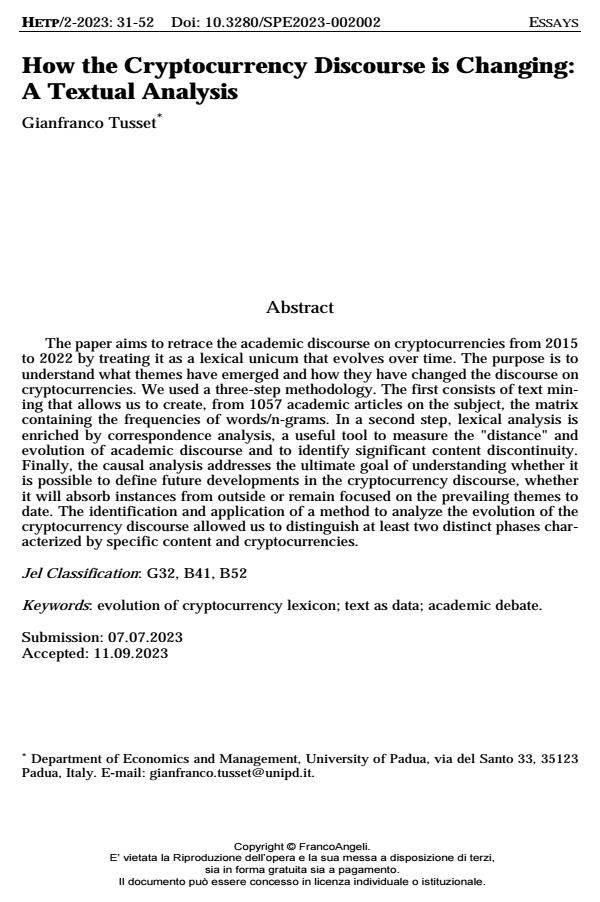How the Cryptocurrency Discourse is Changing: A Textual Analysis
Titolo Rivista HISTORY OF ECONOMIC THOUGHT AND POLICY
Autori/Curatori Gianfranco Tusset
Anno di pubblicazione 2024 Fascicolo 2023/2
Lingua Inglese Numero pagine 22 P. 31-52 Dimensione file 201 KB
DOI 10.3280/SPE2023-002002
Il DOI è il codice a barre della proprietà intellettuale: per saperne di più
clicca qui
Qui sotto puoi vedere in anteprima la prima pagina di questo articolo.
Se questo articolo ti interessa, lo puoi acquistare (e scaricare in formato pdf) seguendo le facili indicazioni per acquistare il download credit. Acquista Download Credits per scaricare questo Articolo in formato PDF

FrancoAngeli è membro della Publishers International Linking Association, Inc (PILA)associazione indipendente e non profit per facilitare (attraverso i servizi tecnologici implementati da CrossRef.org) l’accesso degli studiosi ai contenuti digitali nelle pubblicazioni professionali e scientifiche
The paper aims to retrace the academic discourse on cryptocurrencies from 2015 to 2022 by treating it as a lexical unicum that evolves over time. The purpose is to understand what themes have emerged and how they have changed the discourse on cryptocurrencies. We used a three-step methodology. The first consists of text mining that allows us to create, from 1057 academic articles on the subject, the matrix containing the frequencies of words/n-grams. In a second step, lexical analysis is enriched by correspondence analysis, a useful tool to measure the "distance" and evolution of academic discourse and to identify significant content discontinuity. Finally, the causal analysis addresses the ultimate goal of understanding whether it is possible to define future developments in the cryptocurrency discourse, whether it will absorb instances from outside or remain focused on the prevailing themes to date. The identification and application of a method to analyze the evolution of the cryptocurrency discourse allowed us to distinguish at least two distinct phases characterized by specific content and cryptocurrencies.
Parole chiave:evolution of cryptocurrency lexicon; text as data; academic debate.
Jel codes:G32, B41, B52
- Bitcoin, Altcoins, Digital Ruble: On the Economic Nature of Cryptocurrencies О. N. Volkova, in Finance: Theory and Practice /2025 pp.21
DOI: 10.26794/2587-5671-2025-29-5-21-33
Gianfranco Tusset, How the Cryptocurrency Discourse is Changing: A Textual Analysis in "HISTORY OF ECONOMIC THOUGHT AND POLICY" 2/2023, pp 31-52, DOI: 10.3280/SPE2023-002002